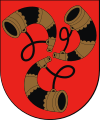
Formerly Piaski Luterskie (Lutheran), this is a town on the Giełczew river with a 2004 population of about 2,660. Administratively in Świdnik Powiat in Lublin Voivodeship, 16 km SE of Świdnik. The town's Jewish community eventually was two-thirds of the total population. in 1795, the Third Partition of Poland made the town part of Habsburg Austria. Passing briefly in 1809 to the Duchy of Warsaw, before joining Congress Poland under Russian rule from 1815 on. Jewish settlement is first documented at the end of the 17th century regarding a murder of a converted Jew by five Jews. Jewish history. Normal 0 At the beginning of the 19th century, Jews constituted 77% of the population. 1921 Jewish population: 2,674 out of 3,974 and 1939: 4,165. In 1940, the Nazis established a ghetto for Jewish inhabitants and several thousand Jews from the Lublin Ghetto and Germany. Germany destroyed many kahal buildings including the brick synagogue built in 1785. In 1942, the ghetto was liquidated with its inmates sent to Belzec or murdered. Holocaust history.
In the 1930's, the population increase required more housing could serve. In 1938, the city council confiscated the old Jewish cemetery for building residential homes. Although the Jewish community protested, the cemetery was destroyed. In November 1942 about 1,000 Jews were murdered at the cemetery, while those remaining alive were transported to the labor camp in Trawniki at the beginning of 1943. That mass grave is unmarked. The Jewish cemetery in ul. Partyzantow behind the primary school building holds a single headstone and a few fallen tombstones. The new cemetery located on ul Rejonie has only individual gravestones, the oldest from 1906 and mass graves for more than 300,000 Jews murdered here by Nazis during WWII. A monument commemorates the victims of the Holocaust. Among the fallen matzevot is trash. [June 2009] [June 2009]
CEMETERY:
Cemetery photos. [January 2006]
burial list [Jan 2015]
PIASKI: (I) US Commission No. POCE000191
Alternate name: Piask in Yiddish. Piaski is located in Lublin, at 51º08 E 22º21, 27 km from Lublin, 43 from Chelm, and 23 from L??? The old cemetery is located at 500 Lecia St. in the center. Present town population is 1,000-5,000 with no Jews.
- Local: Urzad Miasta i Gminy w Lubelska; tel. 122.
- Regional: region Konserwator Zabytkow, Mgr. H. Landecko, Lublin, ul. Litewski 1; tel. 290-35.
The earliest known Jewish community was second half of the 16th century. 1921 Jewish population was 2674 (67.3%). The unlandmarked cemetery possibly was established during the second half of the 16th century. The last known Orthodox Jewish burial was 4th quarter of the 19th century. The isolated urban flat land has no sign or marker. Reached by turning directly off a public road, access is open to all with a broken fence without gate. The approximate size before WWII was and is now still.42 ha. No stones are visible. The municipality owns the property used for the market square. Adjacent property is residential. It is not visited. It was vandalized prior and during World War II. No maintenance. Security is serious threat. The change of site function has caused the cemetery to fall into oblivion.
Pawel Sygowski, r[?illegible] 64/59, 20-201 Lublin; tel. 77-20-78 visited site 11/1991 and completed survey. Josef Honig, Lublin, was interviewed August 1991.
PIASKI (II): US Commission No. POCE000192
The new cemetery is at Michiewicza St., SW of the center. See Piaski (I) for town information. The unlandmarked Jewish cemetery was established during the 4th quarter of the 19th century with last known Orthodox burial in 1943. The isolated suburban flat land has no sign or marker. Reached by turning directly off a public road, access is open to all with a broken fence without gate. The size of the cemetery before WWII was 1.2 and is now 1.29 ha. 1 to 20 stones visible are more than 75% toppled or broken. Removed stones are incorporated into roads or structures. The oldest stone is a double stone dated 1906-1909. The sandstone and concrete flat stones with carved relief decorations date from the 20th century. Inscriptions are in Hebrew. There are unmarked mass graves. For children of the nearby school and waste dump is use of cemetery property. The area is slightly larger. Private visitors rarely visit. The area is slightly larger than it was in 1939. It was vandalized during and after WWII. There is no maintenance. Trees were planted during the 1960s. No care. Vegetation, vandalism and incompatible nearby existing development are serious threats. Vegetation is a constant problem disturbing graves. The area is not fenced. People living in the nearby houses throw their garbage here; children from the nearby school make bonfires and damage the remaining gravestones. It is overgrown with wild greenery. Survey information: see Piaski above.
